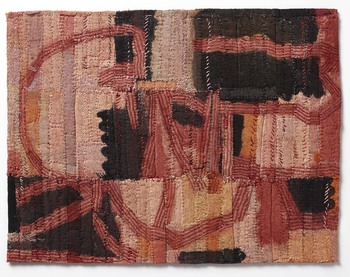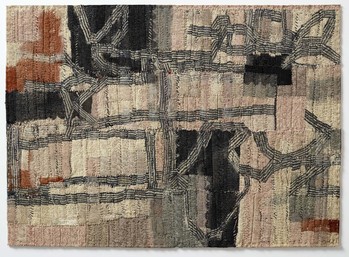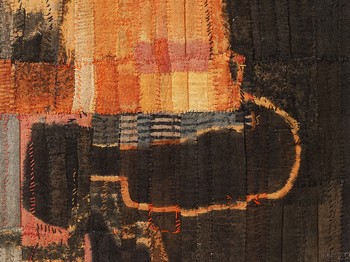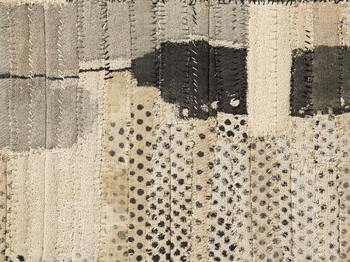Les deux dernières expositions de Matthew Harris, qui se sont tenues en 2023, en Angleterre et au Pays de Galles, sont l'occasion pour celui-ci et son ami Paul Stamper d'échanger sur le travail de l'artiste anglais et de livrer une analyse sur les origines de sa démarche.
L’imagerie abstraite de Matthew Harris
Matthew Harris réalise des œuvres qui font appel à la peinture, au découpage et à la couture à la main. Il s'intéresse principalement à l'imagerie abstraite et à la traduction de marques dessinées en tissu. En réalisant des travaux assemblées, rapiécées et assemblées, il cherche à créer des œuvres qui explorent la répétition, le motif et le chemin perturbé ou dissonant de la ligne et de l'image sur et à travers la surface du tissu.
Toutes les œuvres de Harris utilisent un processus de tension délibérée, d'expansion et de contraction continues, d'action et de réaction, un processus par lequel les couches d'images forment des strates de matériaux incorporés, "ensemencés de potentialité". Les œuvres en tissu sont construites à partir de couches de sergé de coton peint et de mousseline. Les œuvres sur papier sont réalisées à partir de couches de papier de mûrier japonais peintes à l'encre, à la peinture acrylique, au pastel à l'huile, au bâton d'huile et à la cire d'abeille. Le tissu et le papier sont reliés par un fil de lin ciré.  L'artiste découpe le matériau, des formes apparaissent et des lignes, des zones de couleur et de texture sont exposées et un mouvement ludique commence. En creusant à travers les couches, des bribes et des fragments d'images se révèlent. Certains éléments sont conservés et laissés sur place, d'autres sont déplacés, d'autres encore sont déterrés puis enterrés à nouveau. Au gré des matériaux, Harris réagit tantôt rapidement, tantôt plus lentement, jusqu'à ce qu'une composition commence à émerger.
L'artiste découpe le matériau, des formes apparaissent et des lignes, des zones de couleur et de texture sont exposées et un mouvement ludique commence. En creusant à travers les couches, des bribes et des fragments d'images se révèlent. Certains éléments sont conservés et laissés sur place, d'autres sont déplacés, d'autres encore sont déterrés puis enterrés à nouveau. Au gré des matériaux, Harris réagit tantôt rapidement, tantôt plus lentement, jusqu'à ce qu'une composition commence à émerger.
Lors de sa récente exposition à l'Alice Black Gallery de Londres, "A Table of Préparations", première exposition personnelle de Harris à la galerie, celle-ci a présenté un nouvel ensemble d'œuvres construites en tissu et en papier. Le titre de l'exposition est emprunté à une épigramme inventée par le compositeur d'avant-garde John Cage pour décrire les instructions qu'il donnait sur la manière de "préparer" un piano afin de créer un son indéterminé. S'inspirant d'un "jeu de hasard cagéen", l'exposition met en avant les explorations continues de Harris sur les possibilités de composition qui émergent de la spontanéité anarchique. Cage, dès le début des années 1940, fait des expérimentations en plaçant stratégiquement divers objets dans les cordes d'un piano. À l'aide d'une sélection d'objets quotidiens - notamment des écrous et des boulons, des vis, des gommes à effacer, des blocs de bois et des bandes de caoutchouc, de plastique et de carton - Cage a entrepris de transformer l'univers sonore de l'instrument. La voix du piano, autrefois familière, se transforme en une palette de sons intensément colorés et parfois émeutiers. L'idée du "piano préparé" en tant qu'idée visuelle a préoccupé Harris pendant de nombreuses années, depuis qu'il en a vu un préparé pour un concert de musique de Cage au festival de musique de Cheltenham. Un groupe de formes familières et inconnues piégées et maintenues dans la structure verticale des fils du piano présente des similitudes avec la façon dont Harris maintient les images en place avec des lignes de fils enroulés, ou des couches de tissu reliées entre elles par des plis verticaux. 
Les œuvres de (cette) l'exposition à l'Alice Black Gallery sont nées d'une série de formes collectées au fil du temps, à la fois physiquement et photographiquement. Le plus souvent découverts sur le sol, les objets aléatoires et banals écrasés et pressés sur les trottoirs et les chaussées qui attirent l'attention de Harris constituent l'un des points de départ constants de son travail. En adoptant des procédures qui font appel à des jeux de hasard et d'indétermination, ces formes trouvées sont jouées et activement explorées, décomposées et reconfigurées, formant de nouvelles formes et configurations inattendues. Ces méthodologies du hasard comprennent le lancer de dés, le lancer de pochoirs dans un mouvement de frisbee et le suivi d'une formule prédéterminée mettant en corrélation des nombres et des actions. Travailler dans le cadre de ces systèmes permet à Harris de jouir d'une grande liberté.
Pour le catalogue de son exposition personnelle au Ruthin Craft Centre, dans le nord du Pays de Galles, intitulée "Cut, Shift, Repeat", du 8 juillet au 24 septembre 2023, la journaliste et rédactrice en chef du magazine en ligne The Design Edit, Emma Crichton-Miller, écrit : “À première vue, une œuvre de Matthew Harris, qu'elle soit faite de papier ou de tissu, est un objet saisissant. Les motifs abstraits de la surface, entrecroisés par des points de couture ou segmentés par des fils cirés, comme les floraisons accidentelles de cultures et de chemins dans d'anciens champs ou l'audace formelle des partitions musicales graphiques, sont en eux-mêmes séduisants. Mais cette réponse purement esthétique s'accompagne d'une reconnaissance forte de la fabrication comprimée dans chaque pièce. Il s'agit d'images puissantes, porteuses de sens. Et, comme l'indique le titre de cette exposition, la puissance réside dans le processus par lequel l'image a été réalisée, plutôt que dans ses qualités graphiques pures. Car Matthew est avant tout un créateur, qui construit et creuse le sens à partir de la plus petite des inspirations. Ses œuvres sont des enregistrements permanents de l'activité créatrice minutieuse de l'attention imaginative, transformant d'humbles expériences éphémères en œuvres tridimensionnelles qui résonnent.”  Matthew s'est engagé à respecter le commandement zen japonais : "Kan Kyakka", qu'il traduit approximativement par "Prêtez attention à ce qui se trouve sous vos pieds". Ses inspirations sont des bouts de matériaux récupérés ou des souvenirs intenses de choses sans importance - un morceau de feutre de toiture, un paquet de chips froissé, un support en plastique à quatre anneaux pour les canettes de bière, les formes laissées par les machines sur le sol d'une usine abandonnée, une lanterne en papier rose d'Halloween d'un enfant effondrée, sur le trottoir sous un lampadaire. Matthew explore ces objets trouvés de diverses manières, par le dessin et la manipulation, avant qu'ils ne deviennent le point de départ de groupes de dessins et d'œuvres en tissu.
Matthew s'est engagé à respecter le commandement zen japonais : "Kan Kyakka", qu'il traduit approximativement par "Prêtez attention à ce qui se trouve sous vos pieds". Ses inspirations sont des bouts de matériaux récupérés ou des souvenirs intenses de choses sans importance - un morceau de feutre de toiture, un paquet de chips froissé, un support en plastique à quatre anneaux pour les canettes de bière, les formes laissées par les machines sur le sol d'une usine abandonnée, une lanterne en papier rose d'Halloween d'un enfant effondrée, sur le trottoir sous un lampadaire. Matthew explore ces objets trouvés de diverses manières, par le dessin et la manipulation, avant qu'ils ne deviennent le point de départ de groupes de dessins et d'œuvres en tissu.
De la même manière que l'improvisation dans le jazz extrapole à partir du thème d'un morceau standard, des éléments de la forme originale subsistent dans les œuvres de Harris, mais ils ne sont souvent qu'entrevus ou répercutés sous forme de fragments au sein de la nouvelle œuvre. Le processus par lequel Harris crée et construit des images en alternant le papier et le tissu, la peinture et le fil, est devenu un rituel de fabrication et de désinstallation développé au cours de nombreuses années. Le travail de la matière est au cœur de son rituel méditatif, non seulement la matière physique des tissus, mais aussi la matière d'une image. En fin de compte, ce processus permet des possibilités et des variations infinies, explorées dans les limites de la matérialité d'origine. Le plus souvent, Harris réalise des pièces en séries de trois ou plus, qui ont toutes pour point de départ la même image ; des réimaginations variées de ce qui a été.  Les fragments et les bouts d'image qui en résultent, qu'ils soient en papier ou en tissu, sont à la fois complets et incomplets en eux-mêmes, comme s'ils étaient arrachés à un ensemble beaucoup plus vaste. Ce sont des images temporairement liées, maintenues immobiles pour le présent tout en conservant leur potentiel infini de changement.
Les fragments et les bouts d'image qui en résultent, qu'ils soient en papier ou en tissu, sont à la fois complets et incomplets en eux-mêmes, comme s'ils étaient arrachés à un ensemble beaucoup plus vaste. Ce sont des images temporairement liées, maintenues immobiles pour le présent tout en conservant leur potentiel infini de changement.
En allant et venant sur une image, en la travaillant à l'envers et à l'endroit, en la pliant et en la découpant, en l'assemblant et en la recollant, il joue avec le matériau dans un jeu de hasard à la Cage. (Il joue avec le matériau dans un jeu de hasard à la Cage. ) Un jeu dans lequel "rien n'est une erreur, il n'y a ni victoire ni échec, il n'y a que de la création", déplaçant les informations, jouant avec la forme, le rythme, la composition et la hauteur, à la recherche de quelque chose de nouveau, d'une image qu'il n'a jamais vue auparavant, d'une image qui a un certain sens mais qui est nouvelle et inattendue. Comme un musicien qui improviserait autour d'un thème donné, il
essaie d'exploiter et de travailler le matériel limité afin de créer une série de variations.
Matthew Harris, né dans le Kent, vit et travaille actuellement à Stroud, dans le Gloucestershire. Royaume-Uni. Il a obtenu sa licence au cours des beaux-arts textiles du Goldsmiths College of Art (1984-7). Il a exposé au Royaume-Uni, en Europe, aux États-Unis et au Japon et figure dans d'importantes collections publiques, dont le Whitworth Museum and Art Gallery (Royaume-Uni), la Crafts Council Collection (Royaume-Uni) et l'International Quilt Museum, Nebraska (États-Unis). La pratique de Harris s'étend également au domaine de la musique, ayant collaboré en 2014 avec le compositeur britannique Howard Skempton et le Birmingham Contemporary Music Group sur "Field Notes", une tournée de concerts au Royaume-Uni.
Paul Stamper
Matthew Harris creates work that employs painting, cutting, and hand stitching. His practice is primarily concerned with abstract imagery and the translation of drawn marks into cloth. By making work that is pieced, patched, and assembled, he aims to explore repetition, pattern, and the disrupted or dissonant journey of line and image across and through the surface of cloth.
All of Harris’ work involves a process of deliberate tension—continuous expansion and contraction, action and reaction. In this process, layers of imagery form strata of embedded material, “seeded with potentiality.” Cloth works are constructed from layers of painted cotton twill and muslin. The paper works are composed of layers of Japanese mulberry paper painted with ink, acrylic paint, oil pastel, oil stick, and beeswax. Both cloth and paper are bound together with waxed linen thread.
He cuts through the material, revealing shapes, lines, areas of colour, and texture. A playful movement begins. Excavating down through the layers, scraps and fragments of image reveal themselves. Some elements are left where they are; others are removed, unearthed, and then buried again. Flowing with the material itself, Harris responds quickly at times, more slowly at others, until a composition begins to emerge.
Harris was born in Kent and now lives and works in Stroud, Gloucestershire, UK. He received his BA from the Fine Art Textiles course at Goldsmiths College of Art (1984–1987). He has exhibited internationally across the UK, Europe, the US, and Japan, and is represented in major public collections including The Whitworth (UK), the Crafts Council Collection (UK), and the International Quilt Museum, Nebraska (USA). Harris’ practice also intersects with the music world. In 2014, he collaborated with British composer Howard Skempton and the Birmingham Contemporary Music Group on Field Notes, a UK concert tour.
His solo exhibition at the Ruthin Craft Centre in North Wales, titled Cut, Shift, Repeat (8 July – 24 September 2023), was accompanied by an essay by journalist and editor of The Design Edit online magazine, Emma Crichton-Miller. She writes:
“On first viewing, a work by Matthew Harris—whether made from paper or cloth—is an arresting object. The abstract surface patterns, crisscrossed by stitch or segmented by waxed thread, like the accidental blooms of crop and path within ancient field patterns, or the wayward formal daring of graphic musical scores, are in themselves alluring. But with this purely aesthetic response comes a forceful recognition of the manufacture compacted into each piece. These are potent images, pregnant with meaning. And, as the title of this show indicates, the potency lies in the process by which the image has been achieved, rather than in its sheer graphic qualities. For Matthew is intensely a maker—both constructing and excavating meaning from the slenderest of inspirations. His works are permanent records of the painstaking creative activity of imaginative attention, transforming ephemeral, humble experiences into resonant three-dimensional artworks.”
Matthew’s work is rooted in the Japanese Zen phrase Kan Kyakka, which he loosely translates as “Pay attention to what’s beneath your feet.” His inspirations are scraps of salvaged material or intense memories of inconsequential things—a piece of roofing felt, a crumpled crisp packet, a four-ring plastic holder for beer cans, the marks left by machinery on the floor of an abandoned factory, or a collapsed pink Halloween paper lantern beneath a streetlamp. He explores these found objects through drawing and manipulation before they become the starting points for groups of drawings and cloth works.
Much like improvisation in jazz interpolates from the theme of a standard tune, elements of the original shape remain in Harris’ works but often appear only as glimpses or echoes. The process by which he constructs images—through an alternating rhythm of paper and cloth, paint and thread—has become a ritual of making and unmaking developed over many years. Working the material is central to his meditative practice—not just the physical material of fabrics, but the “material stuff” of the image itself. This process allows for infinite possibility and variation explored within the confines of the original material. Harris often creates works in series of three or more, all rooted in the same image—varied reimaginings of what has been.
The resulting image fragments, whether in paper or cloth, are simultaneously complete and incomplete, as if torn from a much larger whole. They are images temporarily bound, held still for the present moment, while retaining infinite potential for change.
By moving back and forth across an image—working with it upside-down, backwards, folding and cutting, piecing and re-piecing—he plays with the material in a Cagean game of chance. A game in which “nothing is a mistake, there is no win and no fail, there is only make.” He moves information around, playing with shape, rhythm, composition, and pitch in search of something new—an image he has not seen before, an image with a hint of familiarity but that remains unexpected. As a musician might improvise on a given theme, Harris seeks to exploit and rework limited material to create a set of variations.
At his recent exhibition at the Alice Black Gallery, London, A Table of Preparations—his first solo show at the gallery—Harris debuted a new body of work in cloth and paper. The exhibition’s title is borrowed from an epigram by avant-garde composer John Cage, referring to the instructions he gave for “preparing” a piano to produce indeterminate sound. Drawing inspiration from a “Cagean game of chance,” the show highlights Harris’ ongoing exploration of compositional possibilities that arise from anarchic spontaneity.
Beginning in the early 1940s, Cage experimented with placing everyday objects—nuts, bolts, screws, erasers, blocks of wood, rubber strips, plastic, and card—into the strings of a piano. This transformed the familiar sound of the piano into an intensely colourful and often riotous palette of sonic textures. The visual idea of the “Prepared Piano” has preoccupied Harris ever since he witnessed one being prepared for a performance of Cage’s music at the Cheltenham Music Festival. The image of familiar and unfamiliar shapes trapped and held within the vertical structure of piano wires resonates with Harris’ own method of holding images in place using lines of wrapped thread or layers of cloth bound together through vertical pleating.
The works in this exhibition originated from a series of shapes collected over time, both physically and photographically. Often discovered on the ground—random, mundane objects squashed into pavements and roads—they form consistent starting points for his work. Using methods that incorporate chance and indeterminacy, Harris plays with these found shapes, actively exploring, breaking down, and reconfiguring them into new, unexpected forms. His methodologies include rolling dice, tossing stencils in a frisbee motion, and following predetermined formulas that correlate numbers to specific actions. These systems, rather than limiting him, provide Harris with a great sense of creative freedom.
{/slider}
